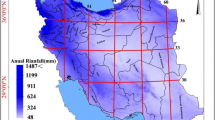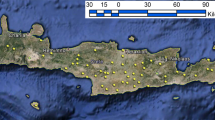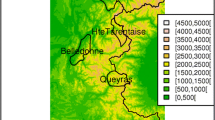Abstract
In order to examine the effect of the Zagros Mountains on precipitation, first, the annual and seasonal rainfall indices (rain days frequency, rain amount, daily rainfall intensity, and heavy rains) from 43 stations in 1995 ∼ 2004 between the 30° N to 35° N parallels over the mountain range were analyzed. Second, the effect of the Zagros Mountains was studied through the computation of the spatial correlations between the precipitation parameters and the topographic indices (station site elevation, station mean elevation within a radius of 2.5 km, mean elevation of 9 blocks along each of the eight Cartesian directions, and the elevation differences of these 9 blocks from the station mean elevation). The results showed that in the cold season the maximal rainfall occurs on the upper range of west slope, while in warm season it spreads over the study area. The correlations between precipitation and elevation indices were positive on the north of the stations and negative on the south of the stations, that is, the higher elevations of the stations to the north force the uplifting of the moist air masses and increase rainfall at the stations, while the lower elevations to their south lead the movement of the moist air masses to the stations. This is due to the fact that these stations or slopes are exposed to the moist air masses coming from the Mediterranean Sea and the Persian Gulf. The heavy rain days and the summer sporadic rain events do not show significant correlations with the topographic indices. The findings indicate that the Zagros Mountains intensify the cold period frontal rains especially over the west slope and block the moist air masses from entering the interior parts of the country. Moreover, these mountains play a secondary role in creating rain days. But they are very important in the production of precipitation in the area. Therefore, their absence will decrease the amount of rainfall to their west and, in return, expand the dry climates of their west and east.
Similar content being viewed by others
References
Alijani, B. 1979. Cyclone Tracks in Relation to the Upper Flow Pattern in the Middle East, Dec.-Mar. 1964–67. M.A. Thesis, M.S.U., E-Lansing, Mi., U.S.A.
Alijani, B. 1981. Synoptic Origin of Precipitation in Iran. Ph.D. Dissertation, M.S.U., E-Lansing, Mi., U.S.A.
Alijani, B. 1996. Climate of Iran. Payam Noor University, Tehran, Iran.
Alijani, B. 2002. Variations of 500 hPa Fow Patterns and their Relationship with the Climate of Iran. Theoretical and applied climatology 72: 41–52.
Alijani, B. and Harman, JR. 1985. Synoptic Climatology of Precipitation in Iran. Annals of Association of American Geographers 75: 404–416.
Barth, H.J. and Steinkohl, F. 2004. Origin of Winter Precipitation in the Central Coastal Lowlands of Saudi Arabia. Journal of Arid Environments 52: 101–115.
Basist, A., Bell, G., and Meentemeyer, V. 1994. Statistical Relationships between Topography and Precipitation Patterns. Journal of climate 7: 1305–1315.
Browning, K.A., Hill, F.F., and Pardoe, C.W. 1974. Structure and Mechanism of Precipitation and the Effect of Orography in a Wintertime Warm Sector. Quarterly Journal of the Royal Meteorological Society 100: 309–330.
Brunsdon, C., McClatchey, J., and Unwin, D.J. 2001. Spatial Variations in the Average Rainfall-altitude Relationship in Great Britain: an Approach using Geographically Weighted Regression. International Journal of Climatology 21: 455–466.
Chaun, G.K. and Lockwood, J.G. 1974. An Assessment of Topographical Controls on the Distribution of Rainfall in the Central Pennines. Meteorological Magazine 103: 275–287.
Daly, C., Neilson, R.P. and Phillips, D.L. 1994. A Statistical Topographic Model for Mapping Climatological Precipitation over Mountainous Terrain. Journal of Applied Meteorology 33: 140–158.
Diodato, N. 2005. The Influence of Topographic Co-variables on the Spatial Variability of Precipitation over Small Regions of Complex Terrain. International Journal of Climatology 25: 351–363.
Drogue, G., Humbert, J., Deraisme, J., Mahr N., and Freslon, N. 2002. A Statistical Topographic Model using an Omniderectional Parameterization of the Relief for Mapping Orographic Rainfall. International Journal of Climatology 22: 599–613.
Elliot, R.D. and Hovind, E.L. 1964. The Water Balance of Orographic Clouds. Journal of Applied Meteorology 3: 235–39.
Evans, J.P., Smith, R.B., and Oglesby, R.J. 2004. Middle East Climate Simulation and Dominant Precipitation Processes. International Journal of Climatology 24: 1671–1694.
Fatahi, E. 2005. Spatial synoptic classification of air masses during dry periods in the south western basins of Iran. PhD. dissertation, Tarbiat Moallem University, Tehran, Iran.
Ghayour, H. and Masoodian, A. 1997. Studying the variations of annual rainfall in Iran. Nivar 29: 6–26.
Govaerts, P. 2000. Geostatistical Approaches for Incorporating Elevation into the Spatial Interpolation of Rainfall. Journal of Hydrology 228: 113–129.
Hevesi, J.A., Flint, A.L. and Istok, J.D. 1992. Precipitation Estimation in Mountainous Terrain using Multivariate Geostatistics. Part I: Structural Analysis. Journal of Applied Meteorology 31: 661–676.
Hevesi, J.A., Flint, A.L. and Istok, J.D. 1992. Precipitation Estimation in Mountainous Terrain using Multivariate Geostatistics. Part II: Isohyetal Maps. Journal of Applied Meteorology 31: 677–688.
Hill, F.F., Browning, K.A., Bader, M.J. 1981. Radar and Rain Gauge Observations of Orographic Rain over South Wales. Quarterly Journal of the Royal Meteorological Society 107: 643–670.
Houghton, J.G. 1979. A Model for Orographic Precipitation in the North-central Great Basin. Monthly Weather Review 107: 1462–75.
Jahanbakhsh, S. and Torabi, S. 2005. Studying the variations of rainfall and temperature Quarterly Journal of Geographical Researches 74: 104–125.
Jahanbakhsh, S. and Zolphegari, H. 2003. Synoptic patterns of the daily rainfall in the west Iran. Quarterly Journal of Geographical Researches 63&64: 234–258.
Johansson B. and Chen D. 2003. The Influence of Wind and Topography on Precipitation Distribution in Sweden: Statistical Analysis and Modeling. International Journal of Climatology 23: 1523–1535.
Khalaj, A. 2002. Analysis of the Role of the Zagros Mountainson the Development of the Synoptic Systems affecting the Climate of the Central Iran. PhD. Dissertation, Tarbiat Modarres University, Tehran, Iran.
Konrad, C.E. 1996. Relationships between Precipitation Event Types and Topography in the Southern Blue Ridge Mountains of the Southeastern USA. International Journal of Climatology 16: 49–62.
Lamb D, et al. 1967. Measurement of Liquid Water Content in Winter Cloud Systems over Siera Nwevada. Journal of Applied Meteorology 15: 763–75.
Masoodian, A. 2006. Identifying the rainfall regimes of Iran by cluster analysis. Geographical Researches 52:47–60.
Peck EL. 1973. Relation of orographic winter precipitation patterns to meteorological parameters. In Distribution of Precipitation in Mountainous Areas. Proceedings of the Geilo Symposium, Norway. WMO publication no. 326, vol. II. Pp. 234–242.
Prudhomme, C. and Reed, D.W. 1998. Relationships between Extreme Daily Precipitation and Topography in a Mountainous Region: a Case Study in Scotland. International Journal of Climatology 18: 1439–1453.
Rahimi, M., Hajjam, S., Khalili, A., Kamali, G.A. and Stigter, C. J. 2007. Risk Analysis of First and Last Frost Occurrences in the Central Alborz region, Iran. International Journal of Climatology 19: 1337–1356.
Saligheh, M. 1999. Synoptic Analysis of the Monsoon Rains of the Southeastern Iran. Ph.D. Dissertation, Tarbiat Modarres University, Tehran, Iran.
Salter, M. de C.S. 1918. The Relation of Rainfall to Configuration. British Rainfall 58: 40–56.
Smith, R.B. 1979. The Influence of Mountains on the Atmosphere. Advances in Geophysics 21: 87–229.
Weston, K.J., Roy, M.G. 1994. The Directional-dependence of the Enhancement of Rainfall over Complex Topography. Meteorological Applications 1: 267–275.
Author information
Authors and Affiliations
Corresponding author
Rights and permissions
About this article
Cite this article
Alijani, B. Effect of the Zagros Mountains on the spatial distribution of precipitation. J. Mt. Sci. 5, 218–231 (2008). https://doi.org/10.1007/s11629-008-0126-8
Received:
Accepted:
Published:
Issue Date:
DOI: https://doi.org/10.1007/s11629-008-0126-8




